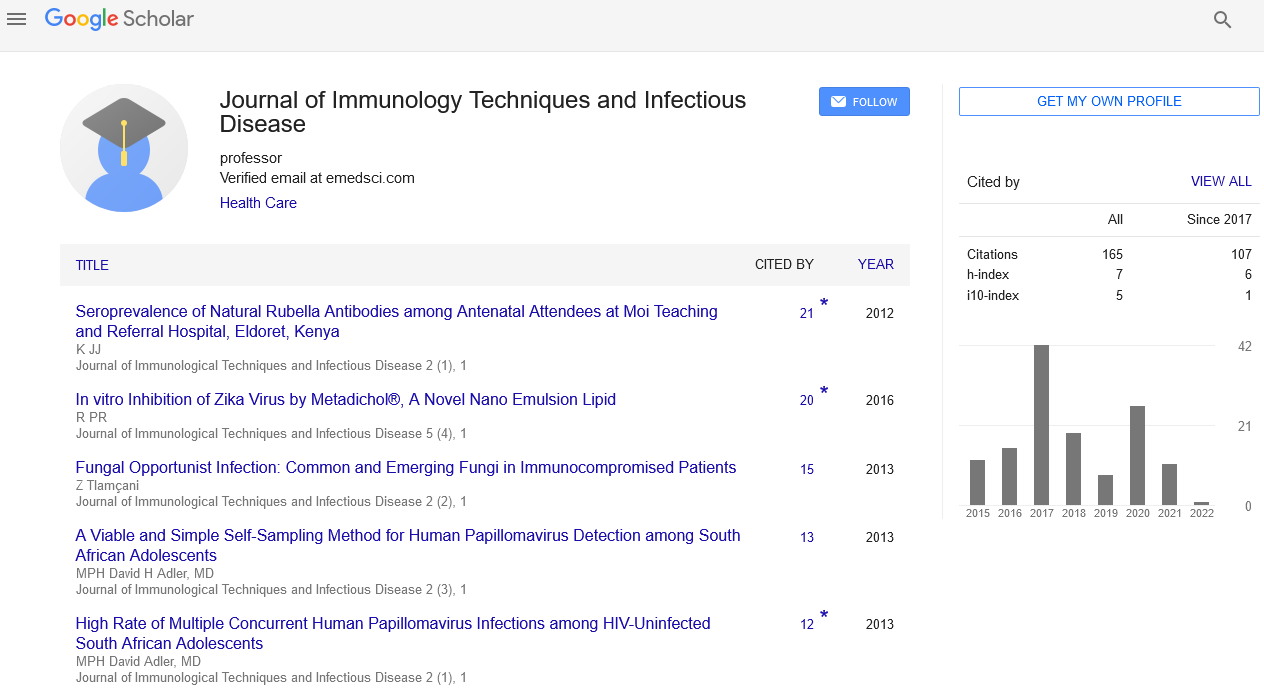Perspective, J Immunol Tech Infect Dis Vol: 12 Issue: 1
Virulence and Viability of Leishmaniasis Diseases
Angela Divento*
Department of Health Sciences, University of Catanzaro, Catanzaro, Italy
*Corresponding Author: Angela Divento
Department of Health Sciences, University of Catanzaro, Catanzaro, Italy
E-mail: angela-divento@gmail.com
Received date: 01-Feb-2023, Manuscript No. JIDIT-23-92827;
Editor assigned date: 03-Feb-2023, PreQC No. JIDIT-23-92827 (PQ);
Reviewed date: 17-Feb-2023, QC No. JIDIT-23-92827;
Revised date: 24-Feb-2023, Manuscript No. JIDIT-23-92827(R);
Published date: 03-Mar-2023, DOI: 10.4172/2329-9541.1000332.
Citation: Divento A (2023) Virulence and Viability of Leishmaniasis Diseases. J Immunol Tech Infect Dis 12:1.
Description
Leishmaniasis is a vector-borne disease caused by Leishmania protozoan parasites it is transmitted by phlebotomine female sand flies of the species Phlebotomus and Lutzomyia, respectively. More than 20 well-known Leishmania species have been identified as infecting humans and causing visceral, cutaneous and mucocutaneous illnesses. An estimated 350 million people are at risk of getting the disease, and 1.6 million new cases are reported each year. Malnutrition, population movement, poor living conditions, a frail immune system, and a lack of resources are all related to the disease, which primarily affects poor populations in Africa, Asia, and Latin America. All suspected Leishmania infections can be diagnosed in three ways-clinically, parasitologically, and immunologically. In some cases, a clinical diagnosis has a very high pretest probability. In the right epidemiological situation, for example, the presence of high-grade fever in conjunction with cytopenias, exceptional splenomegaly, and a significant polyclonal rise of immunoglobulins (particularly of the IgG class) facilitates the diagnosis of Visceral Leishmaniasis (VL). VL infection causes intense activation of innate immunity pathways as well as polyclonal B cell stimulation, which can result in hemophagocytic syndrome and the production of a wide range of autoantibodies, which can lead to misdiagnosis (such as autoimmune hepatitis or systemic lupus erythematosus) or under diagnosis of the disease, particularly in areas of low to moderate endemicity.
Variability in parasite virulence (and other inherent properties) and variability in the host immune response may explain the wide range of clinical symptoms. Mucosal Leishmaniasis (ML) and Leishmaniasis Recidivans (LR) are oligoparasitic diseases with a strong cellular immune response at one end of the range. The most prevalent clinical manifestation, Localised Cutaneous Leishmaniasis (LCL), occurs in the middle of the spectrum. Diffuse Cutaneous Leishmaniasis (DCL) is characterised by a polyparasitic disease with a predominance of parasitized macrophages and no granulomatous inflammation.
• Visceral Leishmaniasis (VL), often known as kala-azar is deadly in more than 95% of patients if left untreated. It is distinguished by irregular bouts of fever, weight loss, spleen and liver enlargement, and anemia.
• Cutaneous Leishmaniasis (CL) is the most prevalent type, causing skin lesions, primarily ulcers, on exposed body parts. These can leave permanent scars and cause significant impairment or stigma.
• Mucocutaneous leishmaniasis causes partial or complete destruction of the nose, mouth, and throat mucous membranes.
Leishmania parasites are spread through the bites of infected female phlebotomine sandflies, which feed on blood to lay eggs. Leishmania parasites can be found in 70 different animal species, including humans. The therapy for leishmaniasis is determined by a variety of criteria, including the kind of disease, coexisting diseases, parasite species, and geographic location. Leishmaniasis is a treated and curable condition that requires an immunocompetent immune system because medications will not remove the parasite from the body, increasing the chance of relapse if immunosuppression develops. All patients with visceral leishmaniasis require urgent and comprehensive therapy. The disease primarily affects poor populations in Africa, Asia, and Latin America and is linked to malnutrition, population migration, poor living circumstances, a weakened immune system, and a lack of resources.
 Spanish
Spanish  Chinese
Chinese  Russian
Russian  German
German  French
French  Japanese
Japanese  Portuguese
Portuguese  Hindi
Hindi 
